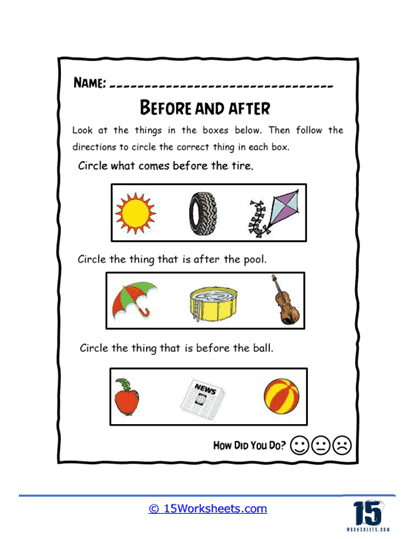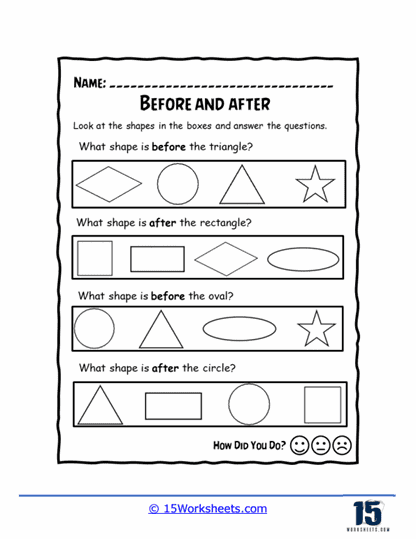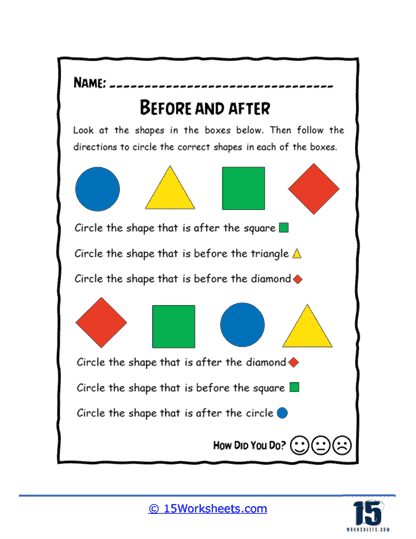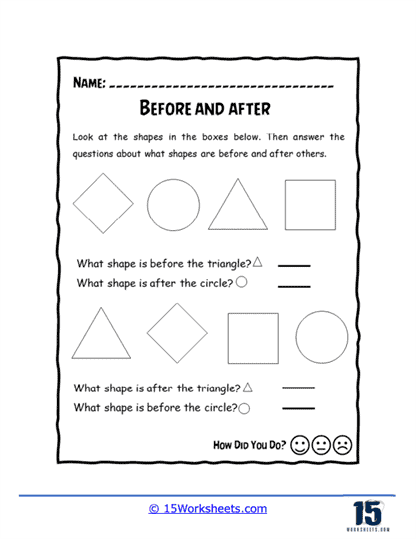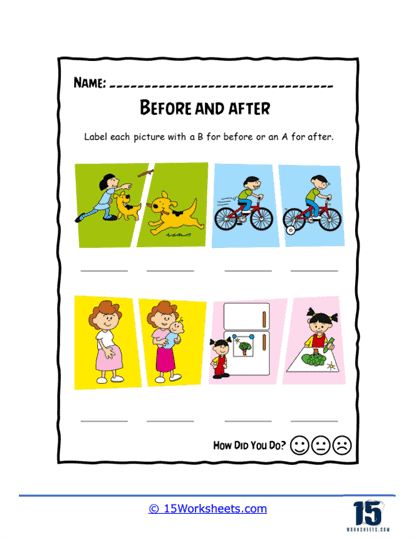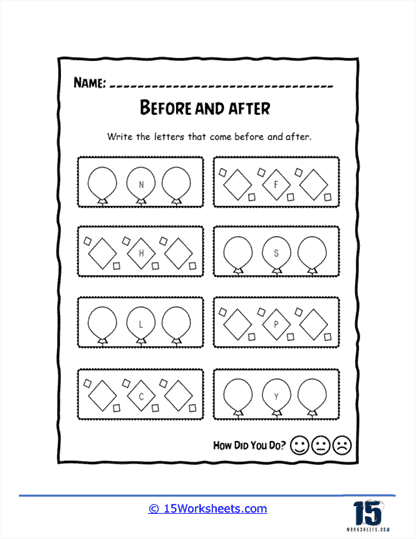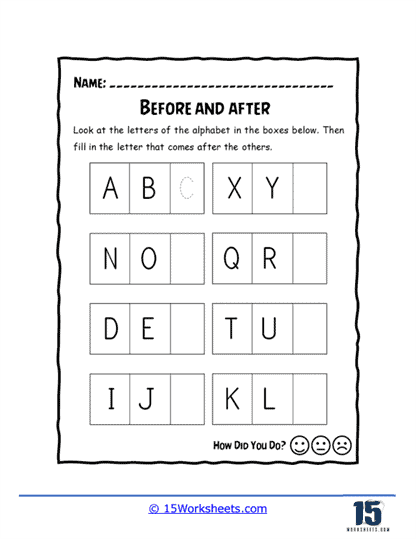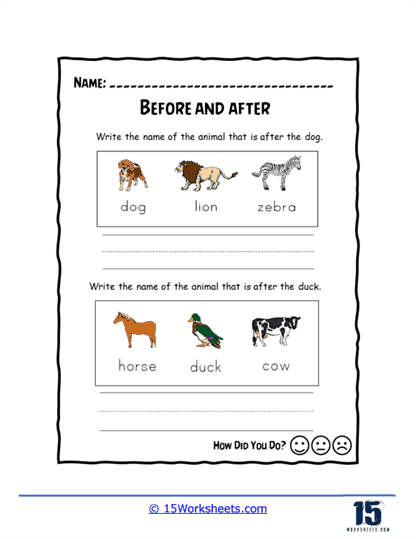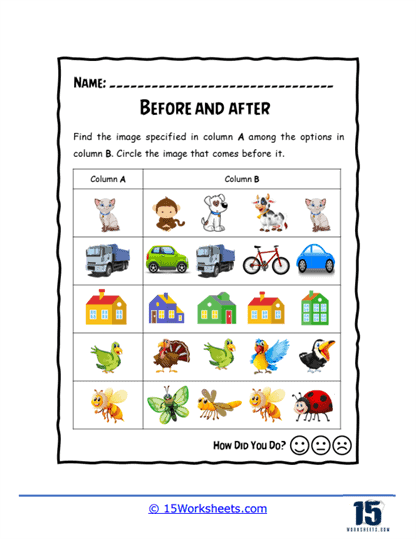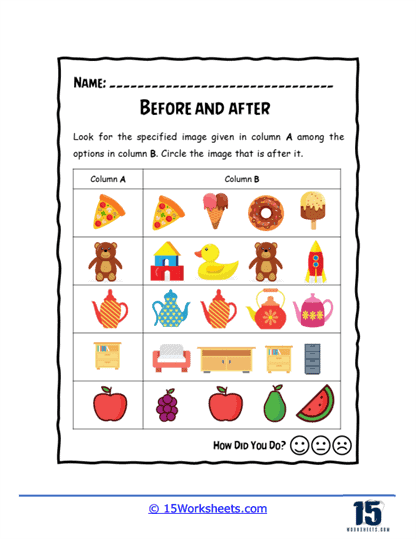Before or After Worksheets
About These 15 Worksheets
If you’ve ever tried explaining the concept of “before” and “after” to a young learner and ended up in a philosophical debate about time travel, you’re not alone. Thankfully, this worksheet collection is here to save the day-and your sanity. This delightful set of 15 worksheets is designed to help children grasp the basics of sequencing and chronology, turning abstract concepts into engaging, hands-on activities.
Each worksheet presents a variety of exercises that challenge students to determine the correct order of events or objects. Whether it’s identifying what comes before or after a given number, arranging pictures to tell a coherent story, or understanding the sequence of daily routines, these activities are crafted to enhance critical thinking and comprehension skills. It’s like giving kids a superpower-the ability to make sense of the world one sequence at a time.
But these worksheets aren’t just educational; they’re also a lot of fun. With activities that include drawing, labeling, and matching, students are actively engaged in their learning process. The interactive nature of the worksheets keeps boredom at bay and encourages a deeper understanding of the material. It’s education disguised as entertainment-a win-win for both teachers and students.
These worksheets are incredibly versatile. They’re suitable for classroom settings, homeschooling, or even as supplementary material for students who need a little extra practice. The clear instructions and varied activities cater to different learning styles, ensuring that every child has the opportunity to succeed. Plus, they’re a great resource for reinforcing concepts taught in other subjects, like math and reading.
So, here’s the deal: the Before or After worksheet collection isn’t just a stack of papers-it’s a time-taming toolkit for little learners! These fun and friendly worksheets help kids master the concept of what comes first and what comes next without anyone needing a time machine or a headache. They’re sneaky-smart, turning tricky sequencing into something playful and totally doable. Whether you’re a teacher, parent, or just someone tired of explaining “after lunch comes what now?” for the hundredth time-this collection has your back. Give these a try, and soon your kiddos will be sequencing like pros, no flux capacitor required!
What are the Positional Terms “Before” and “After”?
Think of “before” as the opening act and “after” as the encore. “Before” is what happens first, and “after” is what happens next. These two are like best friends who always show up in a specific order-one leads the way, the other follows along like a loyal puppy.
Here Are Some Fun Examples
Toothpaste and Toast – Before you brush your teeth, you probably eat your breakfast. That’s because brushing your teeth before chowing down on cereal is like putting on deodorant before a mud run-you’re just going to have to do it again. Plus, minty toothpaste mixed with orange juice? Nope. Breakfast always wins the early morning battle, and brushing comes after as the clean-up crew.
The Epic Shoe-Tying Ceremony – After you tie your shoes, you’re ready to run like a caffeinated squirrel. But before that, your shoelaces are a dangerous trap waiting to take you down mid-stride. You bend down, make the loop-de-loop, pull tight, and voilà-no more tripping over yourself. Only then are you cleared for takeoff (or at least a wobbly jog to the fridge).
Trailers, Treats, and the Movie Marathon – If you’re watching a movie, the trailers come before the main feature. They’re like the appetizer of the cinema world-little sneak peeks that get you hyped up for movies you might not even see. You sit through those, whispering to your friends whether a trailer looks awesome or terrible. Then after all that drama, the real movie begins-and somewhere down the line, your popcorn bucket ends up suspiciously empty.
Math Before Munchies – On a school day, math class might come before lunch. That means your brain does all the heavy lifting while your stomach growls its protest. You’re solving equations, counting numbers, and trying not to think about pizza. Then, sweet relief: after math, lunch arrives like a delicious reward for all your hard work.
Why It Matters
Understanding “before” and “after” helps kids (and adults!) make sense of the world. It’s how we tell stories, follow steps in a recipe, or remember not to put on socks after our shoes (unless we want to confuse the laws of comfort).
In short, knowing what happens when keeps everything running smoothly-from brushing your teeth to building a rocket ship (and yes, you should definitely read the instructions before you launch).
How To Teach The “Before or After” Concept
Here are some strategies and activities that you can use:
1. Story Telling – Start with a simple story with a clear sequence of events. As you narrate the story, emphasize the events that happened ‘before’ and ‘after’.
2. Daily Routines – Use their daily routines to explain the concept. For example, you brush your teeth before you go to bed or you put on your shoes after you put on your clothes.
3. Picture Sequencing – Use picture cards to illustrate a sequence of events. Then, mix up the cards and help them arrange the cards in the right order. Ask them to identify what happens before and after each event.
4. Number Sequencing – Start with simple number sequencing. Ask them what number comes before or after a certain number.
5. Interactive Games – Games such as ‘Simon Says’ can be adapted to this concept. For example, “Simon says, touch your nose and then your toes”, emphasizing the words before and after.
6. Worksheets – Use the worksheets, above, which require students to identify what comes before or after a certain letter, number, or picture.
7. Songs and Rhymes – There are many songs and nursery rhymes that can help children understand the concept of before and after, like “There Was an Old Lady Who Swallowed a Fly”, which has a clear sequence of events.



